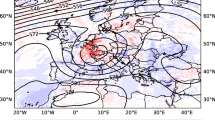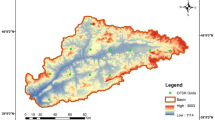Abstract
Areal rainfall is routinely estimated based on the observed rainfall data using distributed point rainfall gauges. However, the data collected are sparse and cannot represent the continuous rainfall distribution (or field) over a large watershed due to the limitations of weather station networks. Recent improvements in remote-sensing-based rainfall estimation facilitate more accurate and effective hydrological modeling with a continuous spatial representation of rainfall over a watershed of interest. In this study, we conducted a systematic stepwise comparison of the areal rainfalls estimated by a synoptic weather station and radar station networks throughout South Korea. The bias in the areal rainfalls computed by the automated synoptic observing system and automatic weather system networks was analyzed on an hourly basis for the year 2021. The results showed that the bias increased significantly for hydrological analysis; more importantly, the identified bias exhibited a magnitude comparable to that of the low flow. This discrepancy could potentially mislead the overall rainfall-runoff modeling process. Moreover, the areal rainfall estimated by the radar-based approach significantly differed from that estimated by the existing Thiessen Weighting approach by 4%–100%, indicating that areal rainfalls from a limited number of weather stations are problematic for hydrologic studies. Our case study demonstrated that the gauging station density must be within 10 km2 on average for accurate areal rainfall estimation. This study recommends the use of radar rainfall networks to reduce uncertainties in the measurement and prediction of areal rainfalls with a limited number of ground weather station networks.



















Similar content being viewed by others
Data availability
No datasets were generated or analysed during the current study.
Abbreviations
- ASOS:
-
Automated synoptic observing system
- AWS:
-
Automatic weather system
- HSR:
-
Hybrid surface rainfall
- KMA:
-
Korea Meteorological Administration
- RMSE:
-
Root mean square error
- ROC:
-
Receiver operating characteristic
- TP:
-
True positive
- TW:
-
Thiessen Weighting
- FP:
-
False positive
References
Ahmed SI, Sharma R, Goel P, Khan A, Gharabaghi B, Rudra R (2022) A comparative evaluation of using rain gauge and NEXRAD radar-estimated rainfall data for simulating streamflow. Hydrology 9(8):133. https://doi.org/10.3390/hydrology9080133
Akgül MA, Aksu H (2021) Areal precipitation estimation using satellite derived rainfall data over an irrigation area. Turk J Agric Food Sci Technol 9(2):386–394. https://doi.org/10.24925/turjaf.v9i2.386-394.4061
Berne A, Krajewski WF (2013) Radar for hydrology: Unfulfilled promise or unrecognized potential? Adv Water Resour 51:357–366. https://doi.org/10.1016/j.advwatres.2012.05.005
Bližňák V, Pokorná L, Rulfová Z (2022) Assessment of the capability of modern reanalyses to simulate precipitation in warm months using adjusted radar precipitation. J Hydrol Reg Stud 42:101121. https://doi.org/10.1016/J.EJRH.2022.101121
Chen T, Ren L, Yuan F, Yang X, Jiang S, Tang T, Liu Y, Zhao C, Zhang L (2017) Comparison of spatial interpolation schemes for rainfall data and application in hydrological modeling. Water (Switzerland) 9(5):342. https://doi.org/10.3390/w9050342
Cheng CD, Cheng SJ, Wen JC, Lee JH (2012) Effects of raingauge distribution on estimation accuracy of areal rainfall. Water Resour Manag 26(1):1–20. https://doi.org/10.1007/s11269-011-9898-7
D’Agostino RB (1986) Goodness-of-Fit-Techniques. Marcel Dekker, INC (ISBN 9780367580346)
Daly C, Neilson RP, Phillips DL (1994) A statistical-topographic model for mapping climatological precipitation over mountainous terrain. J Appl Meteorol 33(2):140–158. https://doi.org/10.1175/1520-0450(1994)033%3c0140:ASTMFM%3e2.0.CO;2
Fulton RA, Breidenbach JP, Seo DJ, Miller DA, O’Bannon T (1998) The WSR-88D rainfall algorithm. Weather Forecast 13(2):377–395. https://doi.org/10.1175/1520-0434(1998)013%3c0377:TWRA%3e2.0.CO;2
Gampe D, Ludwig R (2017) Evaluation of gridded precipitation data products for hydrological applications in complex topography. Hydrology 4(4):53. https://doi.org/10.3390/hydrology4040053
Haberlandt U (2007) Geostatistical interpolation of hourly precipitation from rain gauges and radar for a large-scale extreme rainfall event. J Hydrol (Amst) 332(1–2):144–157. https://doi.org/10.1016/j.jhydrol.2006.06.028
Hall W, Rico-Ramirez MA, Krämer S (2015) Classification and correction of the bright band using an operational C-band polarimetric radar. J Hydrol (Amst) 531:248–258. https://doi.org/10.1016/j.jhydrol.2015.06.011
Hijmans RJ, Cameron SE, Parra JL, Jones PG, Jarvis A (2005) Very high resolution interpolated climate surfaces for global land areas. Int J Climatol 25(15):1965–1978. https://doi.org/10.1002/joc.1276
Hwang SH, Kim KB, Han D (2020) Comparison of methods to estimate areal means of short duration rainfalls in small catchments, using rain gauge and radar data. J Hydrol 588:125084
Hyun JH, Park H, Chung G (2019) Effects of the difference between ASOS and AWS data on runoff characteristics. J Korean Soc Hazard Mitig 19(7):443–449
Kim KB, Kwon HH, Han D (2015) Bias correction methods for regional climate model simulations considering the distributional parametric uncertainty underlying the observations. J Hydrol 530:568–579
Kim TJ, Kwon HH, Lima C (2018) A Bayesian partial pooling approach to mean field bias correction of weather radar rainfall estimates: application to Osungsan weather radar in South Korea. J Hydrol 565:14–26
Kim TJ, Kwon HH, Kim KB (2021) Calibration of the reflectivity-rainfall rate (ZR) relationship using long-term radar reflectivity factor over the entire South Korea region in a Bayesian perspective. J Hydrol 593:125790
Kruizinga S, Yperlaan GJ (1978) Spatial interpolation of daily totals of rainfall. J Hydrol (Amst) 36(1–2):65–73. https://doi.org/10.1016/0022-1694(78)90037-9
Kwon HH, de Assis de Souza Filho F, Block P, Sun L, Lall U, Reis DS Jr (2012) Uncertainty assessment of hydrologic and climate forecast models in Northeastern Brazil. Hydrol Process 26(25):3875–3885
Kwon M, Kwon HH, Han D (2020) A hybrid approach combining conceptual hydrological models, support vector machines and remote sensing data for rainfall-runoff modeling. Remote Sens 12(11):1801
Langousis A, Kaleris V (2013) Theoretical framework to estimate spatial rainfall averages conditional on river discharges and point rainfall measurements from a single location: an application to western Greece. Hydrol Earth Syst Sci 17(3):1241–1263
Lebel T, Bastin G, Obled C, Creutin JD (1987) On the accuracy of areal rainfall estimation: a case study. Water Resour Res 23(11):2123–2134. https://doi.org/10.1029/WR023i011p02123
Li M, Shao Q (2010) An improved statistical approach to merge satellite rainfall estimates and raingauge data. J Hydrol (Amst) 385(1–4):51–64. https://doi.org/10.1016/j.jhydrol.2010.01.023
Lima CH, Kwon HH, Kim YT (2021) A Bayesian Kriging model applied for spatial downscaling of daily rainfall from GCMs. J Hydrol 597:126095
Liu Y, Zhuo L, Pregnolato M, Han D (2022) An assessment of statistical interpolation methods suited for gridded rainfall datasets. Int J Climatol 42(5):2754–2772. https://doi.org/10.1002/joc.7389
Malede DA, Agumassie TA, Kosgei JR, Pham QB, Andualem TG (2022) Evaluation of satellite rainfall estimates in a rugged topographical basin over South Gojjam Basin, Ethiopia. J Indian Soc Remote Sens 50:1333–1346. https://doi.org/10.1007/s12524-022-01530-x
McRoberts DB, Nielsen-Gammon JW (2017) Detecting beam blockage in radar-based precipitation estimates. J Atmos Ocean Technol 34(7):1407–1422. https://doi.org/10.1175/JTECH-D-16-0174.1
Nguyen DH, Kim SH, Kwon HH, Bae DH (2021) Uncertainty quantification of water level predictions from radar-based areal rainfall using an adaptive MCMC algorithm. Water Resour Manage 35(7):2197–2213
O’Bannon T (1997) Using a ‘terrain-based’ hybrid scan to improve WSR-88D precipitation estimates. Preprints, 28th Conf. on Radar Meteorology, Austin, TX. Amer Meteor Soc 506:507
Peterson W, Birdsall T, Fox W (1954) The theory of signal detectability. IEEE Trans Inf Theory 4(4):171–212. https://doi.org/10.1109/TIT.1954.1057460
Rakhecha PR, Singh VP (2009) Applied hydrometeorology. Springer, Dordrecht. https://doi.org/10.1007/978-1-4020-9844-4
Schiemann R, Erdin R, Willi M, Frei C, Berenguer M, Sempere-Torres D (2011) Geostatistical radar-raingauge combination with nonparametric correlograms: methodological considerations and application in Switzerland. Hydrol Earth Syst Sci 15(5):1515–1536. https://doi.org/10.5194/hess-15-1515-2011
Sene K (2013) Flash floods: forecasting and warning. Springer, Dordrecht. https://doi.org/10.1007/978-94-007-5164-4
Seo BC, Krajewski WF, Mishra KV (2015) Using the new dual-polarimetric capability of WSR-88D to eliminate anomalous propagation and wind turbine effects in radar-rainfall. Atmos Res 153:296–309. https://doi.org/10.1016/j.atmosres.2014.09.004
Sherman UD, Johnson LE (1993) Mean areal precipitation estimation using radar. In: Proceedings of the symposium on engineering hydrology, Am. Soc. Civil Eng. (ASCE), pp 638–688
So BJ, Kwon HH, Kim D, Lee SO (2015) Modeling of daily rainfall sequence and extremes based on a semiparametric Pareto tail approach at multiple locations. J Hydrol 529:1442–1450
So BJ, Kim JY, Kwon HH, Lima CH (2017) Stochastic extreme downscaling model for an assessment of changes in rainfall intensity-duration-frequency curves over South Korea using multiple regional climate models. J Hydrol 553:321–337
Taesombat W, Sriwongsitanon N (2009) Areal rainfall estimation using spatial interpolation techniques. ScienceAsia 35(3):268–275. https://doi.org/10.2306/scienceasia1513-1874.2009.35.268
Teegavarapu RSV (2022) Mean areal precipitation estimation: methods and issues. In: Rainfall: modeling, measurement and applications, pp 217–260. https://doi.org/10.1016/B978-0-12-822544-8.00001-9
Valles J, Corzo G, Solomatine D (2020) Impact of the mean areal rainfall calculation on a modular rainfall-runoff model. J Mar Sci Eng 8(12):980. https://doi.org/10.3390/jmse8120980
Veneziano D, Langousis A (2005) The areal reduction factor: a multifractal analysis. Water Resour Res 41(7):W07008. https://doi.org/10.1029/2004WR003765
Verworn A, Haberlandt U (2011) Spatial interpolation of hourly rainfall-effect of additional information, variogram inference and storm properties. Hydrol Earth Syst Sci 15(2):569–584. https://doi.org/10.5194/hess-15-569-2011
Wagner PD, Fiener P, Wilken F, Kumar S, Schneider K (2012) Comparison and evaluation of spatial interpolation schemes for daily rainfall in data scarce regions. J Hydrol (Amst) 464:388–400. https://doi.org/10.1016/j.jhydrol.2012.07.026
Wilks DS (2006) Statistical methods in the atmospheric sciences, vol 91. Academic Press, Cambridge, p 627
Wood SJ, Jones DA, Moore RJ (2000) Accuracy of rainfall measurement for scales or hydrological interest. Hydrol Earth Syst Sci 4(4):531–543. https://doi.org/10.5194/hess-4-531-2000
Xu W, Zou Y, Zhang G, Linderman M (2015) A comparison among spatial interpolation techniques for daily rainfall data in Sichuan Province, China. Int J Climatol 35(10):2898–2907. https://doi.org/10.1002/joc.4180
Yang X, Xie X, Liu DL, Ji F, Wang L (2015) Spatial interpolation of daily rainfall data for local climate impact assessment over Greater Sydney Region. Adv Meteorol 2015. https://doi.org/10.1155/2015/563629
Zhang J, Howard K, Langston C, Vasiloff S, Kaney B, Arthur A, van Cooten S, Kelleher K, Kitzmiller D, Ding F, Seo DJ, Wells E, Dempsey C (2011) National mosaic and multi-sensor QPE (NMQ) system description, results, and future plans. Bull Am Meteorol Soc 92(10):1321–1338. https://doi.org/10.1175/2011BAMS-D-11-00047.1
Zhang T, Li B, Wang J, Hu M, Xu L (2016) Estimation of areal mean rainfall in remote areas using b-shade model. Adv Meteorol 2016. https://doi.org/10.1155/2016/7643753
Acknowledgements
This work was supported by Korea Environment Industry & Technology Institute (KEITI) through Water Management Program for Drought, funded by Korea Ministry of Environment (MOE) (2022003610003). We thank the associate editor and two anonymous reviewers for the valuable comments that greatly improved the original version of the manuscript.
Funding
This work was supported by Korea Environment Industry & Technology Institute (KEITI) through Water Management Program for Drought, funded by Korea Ministry of Environment (MOE) (2022003610003).
Author information
Authors and Affiliations
Contributions
B-J: conceptualization, data curation, methodology, software, validation, formal analysis, writing - original draft preparation.
H.-S: supervision, writing - review & editing.
H-H: conceptualization, methodology, validation, investigation, supervision, writing - review & editing, funding acquisition.
All authors reviewed the manuscript.
Corresponding author
Ethics declarations
Ethical approval
Not applicable.
Consent to participate
Not applicable.
Consent to publish
Not applicable.
Competing interests
The authors declare no competing interests.
Additional information
Publisher's Note
Springer Nature remains neutral with regard to jurisdictional claims in published maps and institutional affiliations.
Rights and permissions
Springer Nature or its licensor (e.g. a society or other partner) holds exclusive rights to this article under a publishing agreement with the author(s) or other rightsholder(s); author self-archiving of the accepted manuscript version of this article is solely governed by the terms of such publishing agreement and applicable law.
About this article
Cite this article
So, BJ., Kim, HS. & Kwon, HH. Spatial pattern of bias in areal rainfall estimations and its impact on hydrological modeling: a comparative analysis of estimating areal rainfall based on radar and weather station networks in South Korea. Stoch Environ Res Risk Assess (2024). https://doi.org/10.1007/s00477-024-02714-2
Accepted:
Published:
DOI: https://doi.org/10.1007/s00477-024-02714-2




